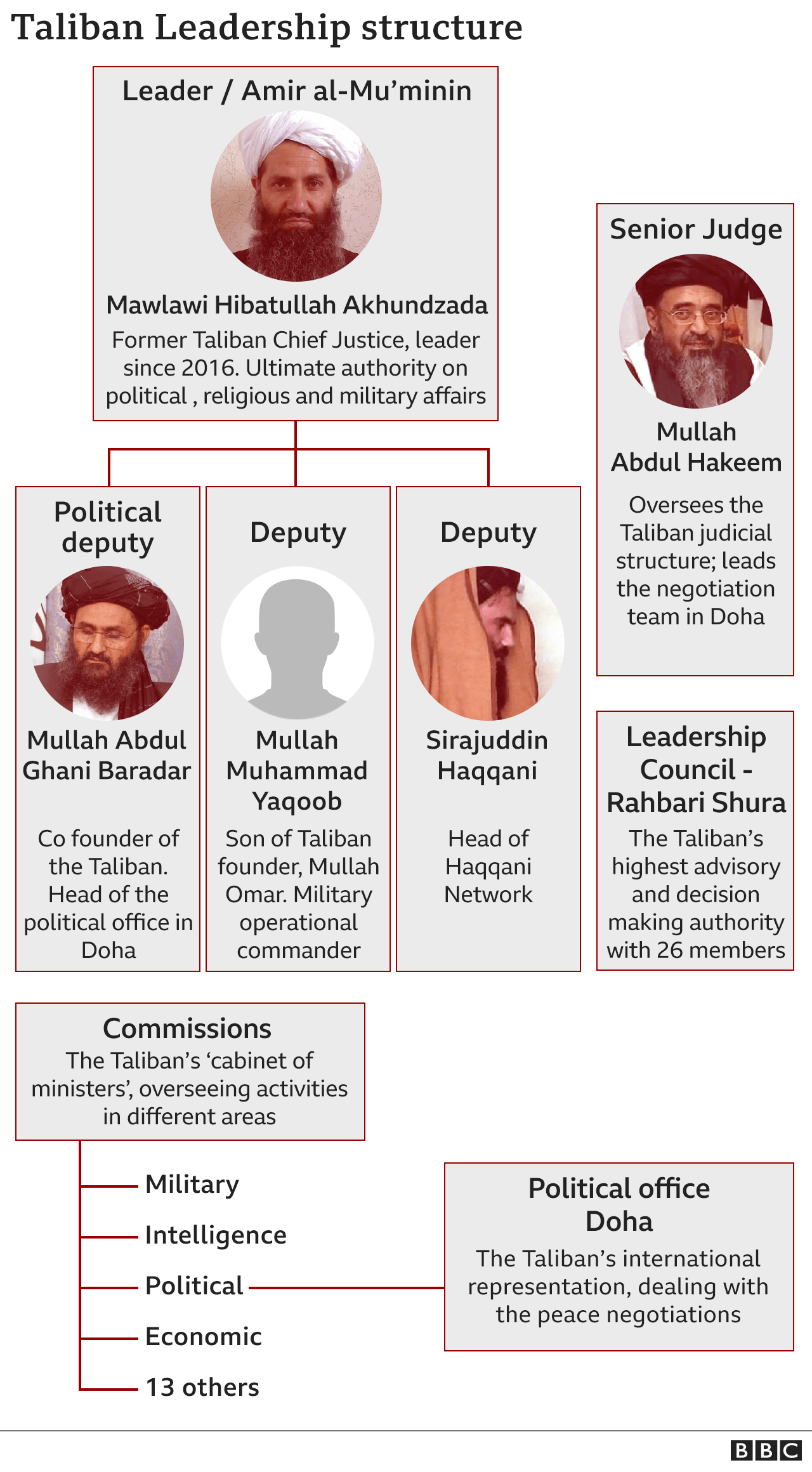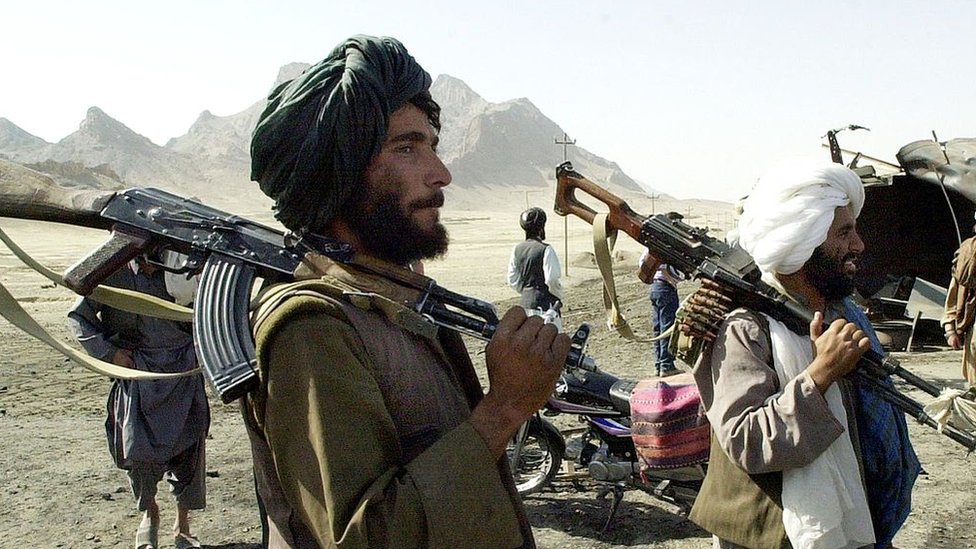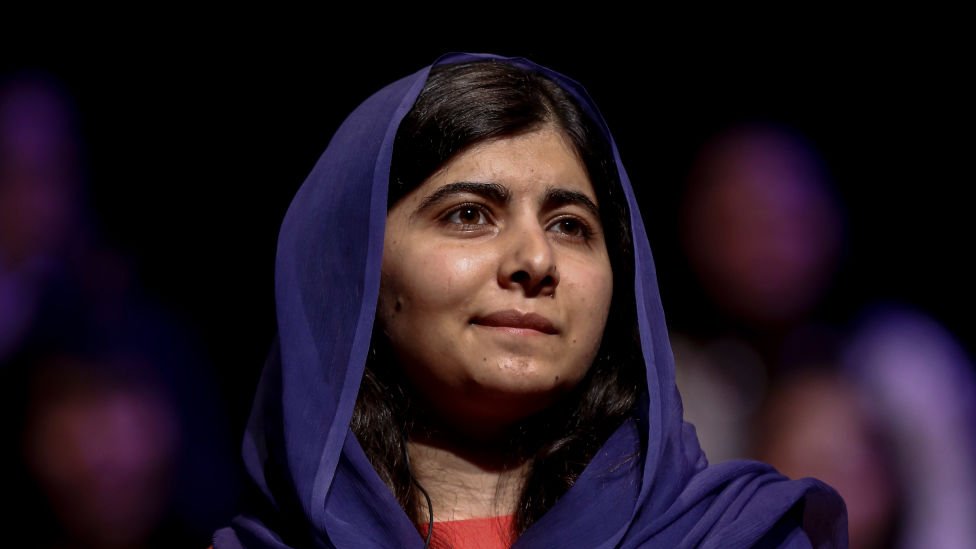
US-led forces comot di Taliban from power for Afghanistan for 2001, but di group don gradually regain strength since and don dey seize territory again.
As di US dey prepare to complete dia withdrawal by 11 September, afta two decades of war, di Taliban dey overrun Afghan military outposts, town and villages and surrounding major cities, dis one dey bring fear once again say dem fit overthrow di goment.
- Wetin dey happun for Afghanistan as militants take control of major cities
- Afghan ministers ‘prepare for peaceful transfer of power’
Di group enter direct talks with US back in 2018, and in February 2020 di two sides strike a peace deal for Doha wey make di US commit to withdraw and di Taliban to prevent attacks on US forces. Oda promises include say dem no go allow al-Qaeda or oda militants to operate for areas wey dem dey control and dem go proceed with national peace talks.
But afta dat year, di Taliban continue to dey target Afghan security forces and civilians. Now, as di US don leave, dey comot dia troops, di group dey ginger and dey advance fast-fast across di kontri.
Rise to power
Na for di early 1990’s di Taliban, or “students” for di Pashto language, show for northern Pakistan afta di withdrawal of Soviet troops from Afghanistan. Di believe na say di predominantly Pashtun movement first appear for religious seminaries – mostly paid for by money from Saudi Arabia – wey dey preach a hardline form of Sunni Islam.
Di promise wey di Taliban make – in Pashtun areas around Pakistan and Afghanistan – na to restore peace and security and enforce dia own serious version of Sharia, or Islamic law, once dem get power.

From south-western Afghanistan, di Taliban quickly extend dia influence. For September 1995, dem capture di province of Herat, wey get border with Iran, and exactly one year later, dem capture di Afghan capital, Kabul, as dem overthrow di regime of President Burhanuddin Rabbani – one of di founding fathers of di Afghan mujahideen wey resist di Soviet occupation. By 1998, di Taliban bin dey in control of almost 90% of Afghanistan.
Afghans, wey bin don dey tire for mujahideen ways and all di inside-fight afta dem drive di Soviets comot, bin generally welcome di Taliban wen dem first appear on di scene. Dia early popularity dey largely due to dia success in stopping corruption, lawlessness and making di roads and di areas under dia control safe for market to flow.
But di Taliban also introduce or support punishments in line with dia strict interpretation of Sharia law – such as public executions of convicted murderers and adulterers, and amputations for those dem find guilty of stealing. Di requirement na say men go grow beards and women get to wear burka wey go cover dem from top to bottom.
Di Taliban also ban television, music and cinema, and no support make girls between di age of 10 and over to go school. Dem accuse dem of various human rights and cultural abuses.

Pakistan don repeatedly deny say dem be di architect of di Taliban enterprise, but little doubt dey say many Afghans wey initially join di movement bin get dia education from madrassas (religious schools) for Pakistan.
Pakistan be also be one of only three countries, along with Saudi Arabia and di United Arab Emirates (UAE), wey recognise di Taliban wen dem bin dey in power for Afghanistan. Dem also be di last kontri to break diplomatic ties with di group.

Al-Qaeda ‘sanctuary’
Di attention of di world dey drawn to di Taliban for Afghanistan afta di 11 September 2001 World Trade Center attacks for New York. Di Taliban bin dey accused of providing sanctuary for di prime suspects – Osama Bin Laden and im al-Qaeda movement.
On October 7, 2001, one US-led military coalition launch attacks for Afghanistan, and by di first week of December di Taliban regime don collapse. Di group den-leader, Mullah Mohammad Omar, and oda senior figures, including Bin Laden, escape capture despite one of di largest manhunts for di world.
Despite di higher numbers of foreign troops, di Taliban gradually regain and den extend dia influence for Afghanistan, wey make large areas of di kontri dey insecure, and violence for di kontri return to levels wey dem never see since 2001.
Plenti Taliban attacks hapun for Kabul and, for September 2012, di group carry out one high-profile raid on Nato Camp Bastion base.
For August 2015, di Taliban bin admit say dem cover up Mullah Omar death – wey reports say im death na sake of health problems for a hospital for Pakistan – for more dan two years. Di following month, di group say dem put aside weeks of infighting and rally around new leader in di form of Mullah Mansour, wey be di deputy of Mullah Omar.
Around di same time, di Taliban seize control of one provincial capital for di first time since dia defeat in 2001, taking control of di strategically important city of Kunduz.
Mullah Mansour die for US drone strike for May 2016 and dem replace am with im deputy Mawlawi Hibatullah Akhundzada, who remain in control of di group.
Despite serious concerns from Afghan officials over goment vulnerability to di Taliban without international support, di new US president, Joe Biden, announce for April 2021 say all American forces go comot di kontri by 11 September – two decades to di day since dem fall di World Trade Center.
One US intelligence assessment di same month don conclude according to reports say di Afghan goment fit fall within six months of di American military departure. And from wetin dey hapun now, dat assessment fit come to reality.





